Bio-organic chemistry
Contents
Lecture 1 .................................................................................................................................................. 3
Lecture 2: ................................................................................................................................................. 9
Lecture 3: ............................................................................................................................................... 11
Lecture 4: ............................................................................................................................................... 17
Summary of all reactions of all lectures: ............................................................................................... 23
Functional groups and atom acidity: ................................................................................................. 23
Acyl substitution, leaving groups and peptide bond formation:....................................................... 24
Peptide bond formation (amide bond): ............................................................................................ 25
Grignard reaction .............................................................................................................................. 26
Hydrides, hydration of aldehydes and ketones................................................................................. 27
Hydride variant for different functional group ................................................................................. 28
Hydride, hydration of carboxylic acid and amides ............................................................................ 28
OH as a leaving group, primary amine > imine reaction, secondary amine > enamine reaction ..... 29
1, 4 addition/ 1,2 addition, keto-enol (base strength dependence) weak base. .............................. 30
........................................................................................................................................................... 30
Keto-enol strong base nucleophile.................................................................................................... 31
Hydration reaction, Acetal/hemi-acetal reaction ............................................................................. 32
Natural hemiacetals: Glucose isomers. Mutarotation ...................................................................... 33
Anomeric effect (hyperconjugation), open form sugars under basic conditions ............................. 34
Open form sugar reduction, open form sugar oxidation, glycosylation (hemi-acetal + alcohol) ..... 35
Glycosylation (sugars and alcohols), glycosylation (sugars and sugars) ........................................... 36
Keto-enol tautomerization (full)........................................................................................................ 37
Enolate............................................................................................................................................... 38
Enolate reactions: Alkylation (symmetrical ketone) ......................................................................... 39
Enolate reactions: symmetrical ketone alkylation continued, list good electrophiles, asymmetrical
ketone alkylation ............................................................................................................................... 40
Enamine alkylation, aldol reactions (gluconeogenesis) .................................................................... 41
Retro-aldol reaction, aldol condensation (water gone) .................................................................... 42
Crossed aldol (2 different aldols) ...................................................................................................... 43
Collagen crosslinking, aldols in citric acid cycle (CAC)....................................................................... 44
Enediol in glycolysis, E1cB reaction in glycolysis (loss of OH group) ................................................. 45
Claisen condensation (2 esters) ........................................................................................................ 46
Crossed Claisen condensation (2 different esters), decarboxylation ................................................ 47
,Carboxylic acid synthesis (using Claisen condensation and decarboxylation) .................................. 48
Fatty acid synthesis: component generation .................................................................................... 49
Fatty acid synthesis: Mechanism....................................................................................................... 50
,Lecture 1
What is electronegativity?
The tendency of an atom to pull electrons towards itself.
The higher the electronegativity, the stronger the pull. This allows molecules with delocalized
electrons to be drawn with different charges to determine the electrophilic atoms.
What are orbitals, what is orbital hybridization and how do they interact to form bonds?
Electrons aren’t balls, they are particles and waves at once with funky mechanics that make them
hard to pinpoint. It can only really be determined where they *can* be rather than where they are. It
was then found that these orbitals where the electrons can be avoid each other in a way when
multiple electron pairs are present in an atom. This creates different shapes.
The first are the two ‘s’ orbitals, which are ball-shaped and holds 2 electrons. They are not
dependent on each other and form layers, essentially.
The second are 3 ‘p’ orbitals, which are each infinity shaped basically and occupy a plane each, and
each hold 2 electrons.
These are the most common, but there are also 5 ‘d’ orbitals and 7 ‘f’ orbitals. Each holds 2 electrons.
A proton has one s orbital and a single electron within it, so it lacks one electron to fill it completely.
In this case it can associate with another atom that also lacks one electron, like another hydrogen
atom. This satisfies both atoms and creates a σ (sigma) bond.
, For bigger atoms it works differently though, as in carbon, with a total of 6 electrons, the 1st s orbital
is completely filled (2 electrons) as is the 2nd s orbital (2 more electrons), and 2 of the p orbitals
contain one each, with one p orbital lacking all electrons. This means that there is still room for more
electrons that can be donated by other atoms. In an excited state one electron from the 2s orbital
can be moved to the empty p orbital to form another receptive orbital, so the core 1s orbital is full,
surrounded by a sort-of empty 2s orbital which is fused, or hybridized, with the 4 receptive p orbitals.
These hybridized orbitals are written as sp3, and can interact with other receptive orbitals like the
previous example of hydrogen could, by overlapping orbitals. This is how bonds are formed and how
carbon can form 4 bonds. This also gives the distinct angles of atomic bonds, as the overlap of the 2s
orbital with the p orbitals makes one end of the infinity rings of the p orbital to swell, while the other
shrinks. This allows the orbitals to fit snugly with each other in a pyramid shape.
With this mechanism it is also possible for less hybridized p orbitals to be formed. This creates double
bonds. Here, 3 of sp2 orbitals are hybridized, creating a flat triangle rather than a pyramid. This allows
one of the sp2 orbitals to overlap and bind to another sp2 orbital, forming a regular bond. However, it
also allows the remaining 2 sp2 orbitals to pull towards the remaining sp2 orbitals of the other carbon
atom, interacting with it and weakly sharing electrons in this way as well. This so-called π (pi) bond
stabilizes the system and locks the molecule into a single plane.
What are delocalized electrons?
First, the localized electrons are shown as bonds in molecules, because like it was described above,
the bonds are formed by two atoms sharing one electron each. The remaining electrons are also
shown in the molecules as dots, for the s orbital that still holds 2 electrons as well. Oxygen for
example can form 2 bonds because it has 2 sp3 orbitals. It still holds 2 full p orbitals, 4 electrons total,




